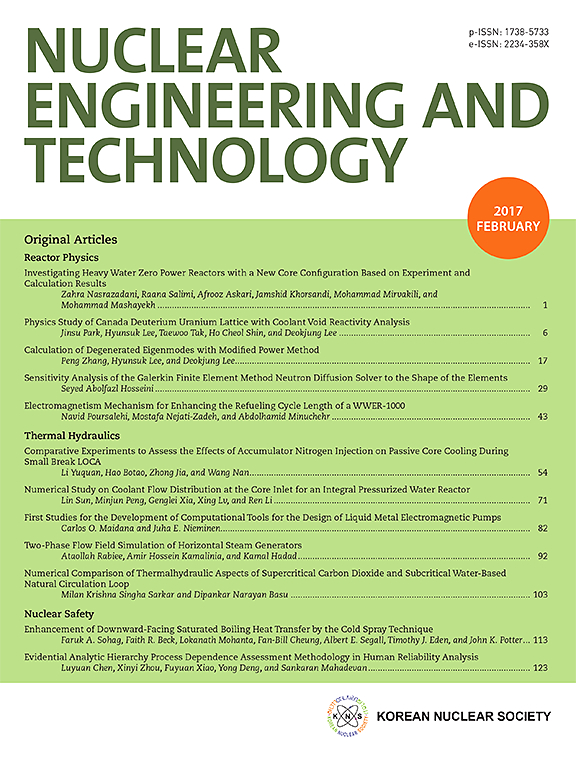Impact of representative ground motion level on seismic PSA with the boundary between overestimation and underestimation
IF 2.6
3区 工程技术
Q1 NUCLEAR SCIENCE & TECHNOLOGY
引用次数: 0
Abstract
One commonly used approach to seismic probabilistic safety assessment (PSA) is the discrete method, which follows the conventional PSA framework and can be applied to various different model types (e.g., multi-unit models). As it is performed using standard software, this method reduces computational costs. However, as intervals cannot be subdivided infinitely, the discrete method instead utilizes an approximation based on a finite number of subintervals. In practice, different numbers of subinterval are applied, and the representative ground motion level is selected based on expert judgment. When employing a smaller number of subintervals, care must be taken to prevent underestimation of risk. The present study analyzes the impact of representative ground motion level on seismic risk, confirming that underestimation can indeed occur with a small number of subintervals, depending on the representative ground motion level. Specifically, using the left endpoint underestimates, the right endpoint overestimates, and the midpoint may do either. It also proposes a method for determining the underestimation-overestimation boundary. This method is demonstrated via examples, affording a mathematical basis for the appropriate selection of representative ground motion levels. Avoiding underestimation helps prevent significant risk contributors from being overlooked and enhances the current understanding of seismic risk.
代表性地震动水平对地震PSA的影响及其高估与低估的边界
地震概率安全评估(PSA)的一种常用方法是离散方法,它遵循传统的PSA框架,可以应用于各种不同的模型类型(例如,多单元模型)。由于使用标准软件执行,该方法减少了计算成本。然而,由于区间不能无限细分,因此离散方法利用基于有限数量的子区间的近似。在实际应用中,采用不同数量的子区间,并根据专家判断选择具有代表性的地震动水平。当采用较少数量的子区间时,必须注意防止低估风险。本研究分析了代表性地震动水平对地震风险的影响,证实了根据代表性地震动水平的不同,确实可以在少数子区间内发生低估。具体来说,使用左端点估计过低,右端点估计过高,而中间点可能两者都有。提出了一种确定过低估计和过高估计边界的方法。通过实例对该方法进行了论证,为合理选择具有代表性的地震动水平提供了数学依据。避免低估有助于防止重大风险因素被忽视,并增强当前对地震风险的认识。
本文章由计算机程序翻译,如有差异,请以英文原文为准。
求助全文
约1分钟内获得全文
求助全文
来源期刊

Nuclear Engineering and Technology
工程技术-核科学技术
CiteScore
4.80
自引率
7.40%
发文量
431
审稿时长
3.5 months
期刊介绍:
Nuclear Engineering and Technology (NET), an international journal of the Korean Nuclear Society (KNS), publishes peer-reviewed papers on original research, ideas and developments in all areas of the field of nuclear science and technology. NET bimonthly publishes original articles, reviews, and technical notes. The journal is listed in the Science Citation Index Expanded (SCIE) of Thomson Reuters.
NET covers all fields for peaceful utilization of nuclear energy and radiation as follows:
1) Reactor Physics
2) Thermal Hydraulics
3) Nuclear Safety
4) Nuclear I&C
5) Nuclear Physics, Fusion, and Laser Technology
6) Nuclear Fuel Cycle and Radioactive Waste Management
7) Nuclear Fuel and Reactor Materials
8) Radiation Application
9) Radiation Protection
10) Nuclear Structural Analysis and Plant Management & Maintenance
11) Nuclear Policy, Economics, and Human Resource Development
 求助内容:
求助内容: 应助结果提醒方式:
应助结果提醒方式:


